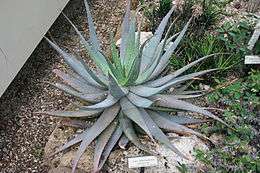Aloe globuligemma
| Aloe globuligemma | |
|---|---|
 | |
| Scientific classification | |
| Kingdom: | Plantae |
| Clade: | Angiosperms |
| Clade: | Monocots |
| Order: | Asparagales |
| Family: | Asphodelaceae |
| Subfamily: | Asphodeloideae |
| Genus: | Aloe |
| Species: | A. globuligemma |
| Binomial name | |
| Aloe globuligemma Pole-Evans | |
| Synonyms | |
| |
Aloe globuligemma is a species of flowering plants in the family Asphodelaceae. It is an evergreen, succulent, perennial plant. The plant forms large, dense clumps. It is harvested from the wild for local medicinal use.
Taxonomy
Aloe globuligemma is a genus in the family Asphodelaceae, subfamily Asphodeloideae.[1]' The species derived its name from Latin language globulus meaning "little ball", and gemma, meaning "bud" [2] referring to the globular flower buds.[3] Common name is witchdoctor's aloe [4]
Description
First description by Illtyd Buller Pole-Evans published in 1915.[5]
Plant morphology
Aloe globuligemma grows, building short stems up to 50 centimeters length, forming great, dense clumps by sprouting. The creeping stems are up to 50 centimeters long.
About 20 of the lance shaped leaves form a rosette. The leaves are from 45 up to 50 centimeters long and from 8 up to 9 centimeters wide. [6]
The milky white, pale brown topped teeth at the leaves margins are 2 millimeters long in 10 millimeters distance, mostly pointing to the leaves top.
Picture [7]
Distribution
Aloe globuligemma is found in Botswana, Zimbabwe and in south african provinces Limpopo and Mpumalanga in hot dry areas bushlands at elevations from 600 to 1325 meters .,[8] often in large colonies, in bare or sparsely grassed places, often in eroded areas and in open deciduous woodland [9]
Uses
Aloe globuligemma is used in Traditional African medicine [10] E.g.A leaf infusion is taken traditionally to relieve stomach-ache, as a cure for venereal diseases and as an abortifacient, although abortifacient activity of the infusion could not be demonstrated in tests.
References
- ↑ Stevens, P.F. (2001 onwards), "Asphodeloideae", Angiosperm Phylogeny Website, retrieved 2016-06-10
- ↑ Urs Eggli, Leonard E. Newton: Etymological Dictionary of Succulent Plant Names. Springer, Berlin/Heidelberg 2010, ISBN 978-3-642-05597-3, p. 95.
- ↑ http://www.zimbabweflora.co.zw/speciesdata/species.php?species_id=113890
- ↑ http://www.itis.gov/servlet/SingleRpt/SingleRpt?search_topic=TSN&search_value=950483#
- ↑ Transactions of the Royal Society of South Africa. Volume5, 1915, p. 30.
- ↑ Urs Eggli: Glossary of Botanical Terms with Special Reference to Succulent Plants including German equivalents. British Cactus and Succulent Society, Richmond 1993, ISBN 0-902099-22-1, p. 41.
- ↑ http://lifestyleseeds.co.za/index.php?page=shop.product_details&product_id=672&flypage=flypage.tpl&pop=0&option=com_virtuemart&Itemid=71&vmcchk=1&Itemid=71
- ↑ http://www.koeltz.com/product.aspx?pid=175130
- ↑ http://tropical.theferns.info/viewtropical.php?id=Aloe+globuligemma
- ↑ Arnold, T.H., Prentice, C.A., Hawker, L.C., Snyman, E.E., Tomalin, M., Crouch, N.R. & Pottas-Bircher, C. (2002). Medicinal and Magical Plants of Southern Africa: An Annotated Checklist. Strelitzia. 13: 1-203.
Bibliography
- Susan Carter, John Jacob Lavranos, Leonard Eric Newton, Colin C. Walker, Aloes. The definitive guide, Publisher Kew Publishing,Royal Botanic Gardens, Kew, 2011, ISBN 978-1-84246-439-7, pages=459
- Leonard Eric Newton, editor Urs Eggli, Aloe globuligemma, Sukkulenten-Lexikon. Einkeimblättrige Pflanzen (Monocotyledonen), Verlag=E, Stuttgart, 2001, ISBN 3-8001-3662-7| pages=141 (German)
- Arnold, T.H., Prentice, C.A., Hawker, L.C., Snyman, E.E., Tomalin, M., Crouch, N.R. & Pottas-Bircher, C. (2002). Medicinal and Magical Plants of Southern Africa: An Annotated Checklist. Strelitzia. 13: 1-203.
- Massey, Jimmy R.; Murphy, James C. (1996). "Vascular plant systematics". NC Botnet. University of North Carolina at Chapel Hill. Retrieved 19 January 2016.
- R J Ferry. Inflorescences and Their Names. The McAllen International Orchid Society Journal.Vol. 12(6), pp. 4–11 June 2011
- Carter, S., Lavranos, J.J., Newton, L.E. & Walker, C.C. (2011). Aloes, The Definitive Guide Royal Botanic Gardens, Kew ISBN 978 1 84246439 7 Page 459. (Includes a picture).
- Mapaura, A. & Timberlake, J. (eds) (2004). A checklist of Zimbabwean vascular plants Southern African Botanical Diversity Network Report No. 33 Sabonet, Pretoria and Harare Page 84.
- Setshogo, M.P. (2005). Preliminary checklist of the plants of Botswana. Sabonet Report no. 37. Sabonet, Pretoria and Gaborone Page 115.
- West, O. (1974). A Field Guide to the Aloes of Rhodesia. Longman, Salisbury Pages 80 – 84. (Includes a picture).